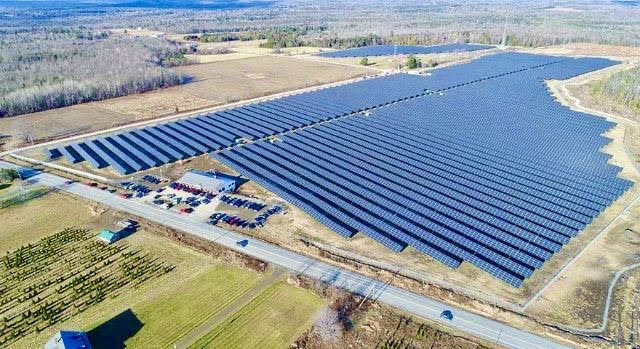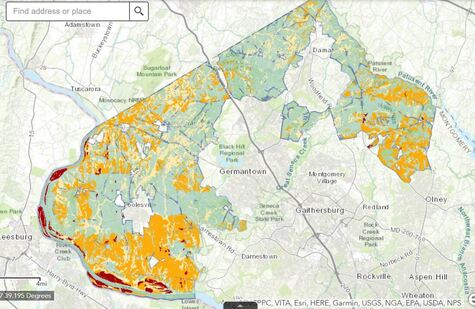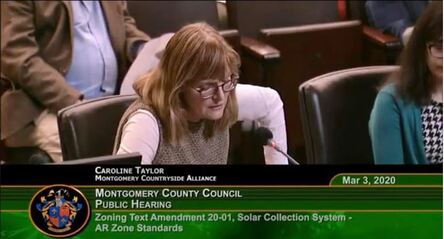-Around 3 square miles of commercial scale solar is proposed for Montgomery County's Ag Reserve under ZTA 20-01, first proposed in January 2020. The ZTA will have a vote in September at the full County Council.
-Despite many hundreds of letters of concern since January from both up and downcounty, this ZTA still has scant/toothless protection for water quality, forests, and notably productive soils - this in the only part of the County set aside for Agriculture. Reserve farms are mostly on productive soil classes 2 and 3 - there are no protections for these soils in this ZTA (map and table of who farms what soil here). In fact the architect of this ZTA, Councilmember Hans Riemer really showed his retisence to protect agriculture in the Ag Reserve when he said the difference between soil types allowed for siting commercial arrays was akin to roof color, asking "Why would we limit solar to only blue roofs?"
@hansriemer soil class on a farm will determine what food can be grown, comparing it to roof color is rather ludicrous.
— MoCoAlliance (@MoCoAlliance) July 22, 2020
-Though we all want to see the county embrace renewable energy, there is disagreement about this flawed ZTA among local environmental groups. Here are the misconceptions supporters of this ZTA have - notably that arrays would have to be part of the Maryland Community Solar Portfolio meant to be accessible to low income people- false. Without clear stipulation that these commercial facilities will be part of the community solar initiative, energy generated will simply flow to the regional grid providing neither affordable energy for local consumers nor satisfying Montgomery County’s mandate for carbon neutral by 2035.
Before the Council votes on this ZTA next month, they need to hear from you, or hear from you again. Please take 2 minutes to take action - and thank you!
It seems that despite the pandemic, the council will be taking up this ZTA allowing siting industrial solar arrays in the Ag Reserve with no protections for productive soils or forests. The findings of the county's climate working group are clear as the Working Group Chair (reiterated in an email here to the Council here and again by MCA and also by Reserve Architect Dr. Royce Hanson. ) - the Ag Reserve is not the place for industrial solar. (The Maryland Farm Bureau agrees)
An Electrical Systems Engineer Expert Weighs In "You can't change the laws of Physics....ZTA 20-01 is not the answer."
The pandemic makes it very difficult for people to properly participate in the public process (particularly in the Ag Reserve where broadband is not universal) but it has put a fine point on the critical value of local farms and local food. Our Land Link program has connected new and expanding farmers with over 500+ acres of leased land. Non-Ag uses like industrial solar make land leases, the lifeblood of farm ventures large and small in MoCo, much less likely to happen with severe impacts on next generation table crop producers - particularly those from under represented backgrounds. Multi generation ag producers are also opposed to this ZTA.
Click Read More on below for all the background on this issue.
Huge thanks to those who have given their voices through correspondence/calls in the quest to get this right.
There is still time to weigh in as the zoning proposal goes to committee later this month. Writing in takes 2 minutes when you use our quick letter writer here.
Hearing can be viewed here
Read our full hearing wrap up here
Another link of interest - the Abell Foundation of Baltimore has released a report on best practices for siting solar arrays in Maryland - spoiler alert- not on prime farmland.
- putting arrays in wetlands and stream corridors
- arrays are fine for prime soils, no protections necessary
- arrays are fine on steep slopes (according to solar promotional material in front of him)
- no need to wait for tax payer funded County climate change working group and contractor plan
- MCA's Testimony delivered at the Hearing on 3/3 "The stated premise that our protected farmland and open space must give way right now to an industrial use because of urgency and in the absence of a comprehensive plan is deeply flawed"
- Read comments on this ZTA from Royce Hanson (architect of the Ag Reserve and Chair of MCA's Advisory Committee). Bottom Line: "While the motives for the ZTA may be noble, it would seem prudent to think a bit more before acting; to first develop a strategy for achieving the county’s commendable green energy goals in the context of a regional and state strategy. The technology and its costs are changing rapidly. Time is of the essence, but so is avoiding harm in the rush to do good."
- League of Women Voters - LWV of MoCo say look to the master plan and don't change the zoning of the Ag Reserve.
- The Bethesda- Chevy Chase Chapter of the Izaak Walton League Opposes this ZTA "From a conservation, agricultural and food security perspective, more thought must be given to the alternative uses of the spaces on which solar arrays may be placed."
- West Montgomery County Citizens Association "Until all possibilities have been explored, there is no excuse for sacrificing farmland."
- Montgomery County Stormwater Partners Network (38 local civic orgs) "To be in harmony with the Ag Reserve’s climate response role, County zoning code must guide utility-scale solar to compatible locations. This ZTA must wait until the County’s Climate Action Plan and General Plan Update (Thrive 2050) are completed."
Learn more about this ZTA and take action (before 3/1) here.
Read testimony from our Executive Director made at the Poolesville Town Hall on this ZTA.
As introduced, there is no requirement in ZTA 20-01 that the new solar generator be in the state’s community solar program.
The only limitation on the type of solar is that it must be capable of being connected to the electric grid.
Jeff Zyontz
Senior Legislative Analyst
Montgomery County Council
- With programs like Re-Leaf the Reserve which provides plantings of native trees to sequester carbon, reduce flooding and improve air quality,
- The promotion of regenerative agricultural practices which increase resilience to climate change
- And helping to preserve farmland to ensure food security in close proximity to our metro center
- As laid out in MCA's Climate Change Response position statement from March 2019- carbon reductions must go hand in hand with water quality protection and other goals as outlined in the Master Plan.
Farmland and Agriculture:
- North Carolina has moved more substantively into solar arrays on farmland. Extension agents and crop scientists are sounding the alarm on the long term effects of solar for the land and the economy:"Big Solar Farms May be Stressing the Agricultural Ecosystem" Carolina Journal
- In Virginia, rural tidewater counties are also dealing with solar companies seeking large tracts of cheap land. The MCA equivalent organization in Essex County, VA details the water quality challenges, economic issues and other problems with the solar boom there.
- The Wilderness Society answers the question "Where should we site renewable energy production?" - industrial areas.
- The Impact of Renewable Energy Generation on Wildlife - University of Nebraska Lincoln
- Re-Planting Forests is a powerful and cost effective piece of the climate change solution - However, forests themselves are at risk as the result of warming temperatures. Clear cutting for solar releases greenhouse gasses. USDA Mid-Atlantic Forest Vulnerability Assessment
- Industrial Solar has big impacts around the world If planned thoughtfully, solar projects can avoid land-use conflict. "The Dark Side of the Sun: Avoiding Conflict Over Solar Energy’s Land and Water Demands" The Wilson Center
- In Brooklyn, affordable housing is a new frontier for solar installations that have benefits for owners and tenants.









